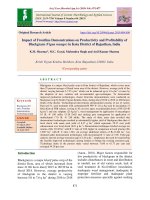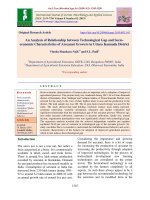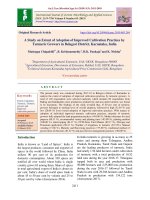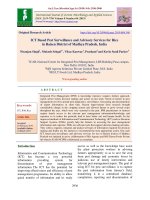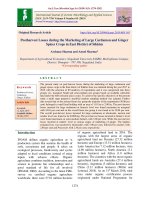Entrepreneurial behaviour of flower growers in Tumkur district of Karnataka state
Bạn đang xem bản rút gọn của tài liệu. Xem và tải ngay bản đầy đủ của tài liệu tại đây (263.61 KB, 8 trang )
Int.J.Curr.Microbiol.App.Sci (2019) 8(3): 656-663
International Journal of Current Microbiology and Applied Sciences
ISSN: 2319-7706 Volume 8 Number 03 (2019)
Journal homepage:
Original Research Article
/>
Entrepreneurial Behaviour of Flower Growers in
Tumkur District of Karnataka State
N. Bindu*, Y.N. Shivalingaiah and N.V. Shwetha
Department of Agricultural Extension, UAS, GKVK, Bengaluru – 560 065, Karnataka, India
*Corresponding author
ABSTRACT
Keywords
Entrepreneurial
behaviour,
Innovativeness, Decision
making ability,
Achievement motivation,
Knowledge about
farming enterprise, Risk
orientation, Ability to coordinate farm activities,
Information seeking
Behaviour, Economic
motivation, Leadership
ability, Scientific
orientation and
Management orientation
Article Info
Accepted:
07 February 2019
Available Online:
10 March 2019
The study was conducted during the year 2017-18 in Tumkur district of Karnataka state to
measure the entrepreneurial behaviour of flower growers. In Tumkur district, Madhugiri
taluk was purposefully selected for the study, since it is dominated with the major flower
growing areas. Four villages of Madhugiri taluk were considered for the research purpose
and forty chrysanthemum, forty jasmine and forty crossandra growers were selected
randomly from each of the village. Thus, leading to the total sample size of 120. To
quantify the entrepreneurial behaviour of flower growers, eleven dimensions like
innovativeness, decision making ability, risk orientation, achievement motivation,
knowledge of farming enterprise, ability to co-ordinate farm activities, information seeking
behaviour, economic motivation, leadership ability, scientific orientation and management
orientation were considered. Exactly half (50.00 %) of the chrysanthemum growers, 37.50
per cent of jasmine growers and about two-fifth (42.50 %) of the crossandra growers were
observed to possess medium level of entrepreneurial behavior. With respect to overall
entrepreneurial behaviour of the flower growers, more than two-fifth (43.34 %) of them
falls under medium category. When comes to dimensions wise distribution of flower
growers in total, significant percentage of them belongs to low category of ability to
coordinate farm activities (37.50 %) and leadership ability (46.66 %), medium category of
decision making ability (44.16 %), knowledge on farming enterprise (45.83 %), risk
orientation (36.66 %), economic motivation (49.00 %), scientific orientation (51.66 %) and
management orientation (41.66 %), high category of innovativeness (35.83 %),
achievement motivation (43.33 %), and information seeking behavior (44.16 %).
Introduction
India is predominantly an agriculture based
country. Almost two third of the population in
India depends on agriculture for their
livelihood. It has become the main source of
income. In rural India, it is the largest provider
for the livelihood of people. Agriculture is
providing employment for half of the
country’s workforce and it is considered as the
single largest private sector occupation.
Agricultural contribution to the country’s
Gross Domestic Product has been declined
from 52.00 per cent in 1960-61 to 18.50 per
cent at present. Share of agriculture in total
GDP reflects its direct contribution to the
656
Int.J.Curr.Microbiol.App.Sci (2019) 8(3): 656-663
national economy. Though there is a decline in
the share of agriculture to India’s GDP, its
contribution is significance in total country’s
GDP. Despite declining agriculture share in
the economy, majority of rural workforce
continue to depend on agriculture for
employment.
Horticultural crops have improved economic
condition of farmers because of higher returns
from many perennial flower crops, plantation
crops, seasonal availability of fruits and
vegetables throughout the year. Growing
horticultural crops has been recognized as an
ideal option for the improvement of livelihood
security, attaining income and food security,
enhancing employment generation and
increasing income through value addition. It
has also played a crucial role in women
endowment, as it provides employment
opportunities in vegetable production,
floriculture, mushroom cultivation etc.
Floriculture is regarded as an age old farming
activity in India possessing immense potential
to generate gainful self-employment and
entrepreneurship among small and marginal
farmers. After liberalization, floriculture was
identified as a sunrise industry in India. The
liberalization of trade and industrial policies
had led to the development of export oriented
cut flower production. Because of the new
seed policy, it is also possible to import the
planting material and seeds of international
varieties.
Rural development is more than ever before
linked entrepreneurship. It plays a key role in
economic development of the country.
Entrepreneurship stands as a vehicle to
improve the quality of life for individuals,
families and communities and to sustain a
healthy economy and environment.
Entrepreneurship can be taken up in a wide
range of fields like Business, Agriculture,
Horticulture, Education, Dairy Industry,
Social Works etc. Scientific and advanced
agriculture is mainly based on capital
investment and output. Hence, it also requires
entrepreneurship. In developing countries like
India, the role played by entrepreneurs is of
great importance. Thus in all developmental
activities more attention should be given to the
entrepreneurship development.
The entrepreneurial behaviour is a crucial and
indispensable factor for the growth of
Horticulture farming. Development of any
nation’s economy primarily depends on the
main role played by entrepreneurs. A
considerable amount of research about the
personal traits and behaviour of entrepreneurs
have been conducted in recent years. But, the
precise identification of entrepreneurial talent
remains elusive. Thus, considering the
importance of entrepreneurship and role
played by the entrepreneurs in the horticultural
growth and development, the study intended
to measure the entrepreneurial behaviour of
flower growers.
Materials and Methods
The investigation was carried out in Tumkur
district of Karnataka, during the year 2017-18
to study the entrepreneurial behaviour of
flower growers. In Tumkur district, Madhugiri
taluk was purposefully selected for the study
by recognizing the importance of the
floriculture as an income and employment
generating activity in the taluk. The top four
villages which have the highest area under
flower cultivation were selected from the
taluk. Then, from each village, 40
chrysanthemum, 40 jasmine and 40 crossandra
growers were picked randomly. Thus, the total
number of the respondents considered for the
study was 120. Ex-post facto research design
was employed in the present study. Data was
collected by using a detailed pre tested
interview schedule and employed personal
657
Int.J.Curr.Microbiol.App.Sci (2019) 8(3): 656-663
interview method. The responses were scored,
quantified, categorized and tabulated using
statistical methods like percentage, mean,
standard deviation and frequencies.
Results and Discussion
Overall entrepreneurial
flower growers
behaviour
of
Table 1 indicates the overall entrepreneurial
behaviour of flower growers. Among
chrysanthemum growers, half (50.00 %) of
them possess medium entrepreneurial
behaviour followed by high (30.00 %) and low
(20.00 %). Among the jasmine growers, 37.50
per cent, 32.50 and 30.00 per cent belongs to
medium, high and low categories respectively.
About two-fifth (42.50 %) of the crossandra
growers show medium entrepreneurial
behaviour followed by low (32.50 %) and high
(25.00 %). With respect to overall
entrepreneurial behavior of the flower
growers, more than two-fifth (43.34 %) of
them falls under medium category followed by
high (29.16 %) and low (27.50 %)
entrepreneurial behaviour group. The reason
for medium entrepreneurial behaviour of
farmers might be due to the fact that study
area is more suitable for flower cultivation.
The other reason also might be that significant
association was found between education,
occupation, land holding, annual family
income, extension participation, mass media
participation, self-reliance, cosmopoliteness
and deferred gratification with entrepreneurial
behaviour of the flower growers.
(32.50 %) and low (30.00 %) innovativeness.
Among the jasmine growers, 45.00 per cent,
32.50 per cent and 22.50 per cent belonged to
high, medium and low innovativeness category.
Slightly less than half (47.50 %) of the
crossandra growers belonged to low
innovativeness followed by medium (27.50 %)
and high innovativeness (25.00 %) category.
The
flower
growers
possess
high
innovativeness (35.83 %) followed by low
(33.33 %) and medium (30.83 %)
innovativeness. The trend might be due to the
fact that innovative flower growers usually
have more favourable attitude towards adoption
of new technologies, while medium
innovativeness is due to moderate participation
of flower growers in extension activities and
mass media programmes. However, low
innovativeness might be due to fact that flower
growers wait for other members in his social
system to adopt the innovation and achieve
success and also their poor economic condition
might have prevented them to adopt new
innovations.
Decision making ability
It is evident from the Table 2 that, slightly less
than half (47.50 %) of the Chrysanthemum
growers belonged to medium decision making
ability category. Whereas, 35.00 and 17.50 per
cent of them belonged to high and low
decision
making
ability
categories,
respectively. Among the Jasmine growers
40.00, 32.50 and 27.50 per cent belonged to
medium, low and high decision making ability
category. More than two-fifth (45.00 %) of the
Crossandra growers have medium decision
Entrepreneurial behaviour component wise making ability followed by low (37.50 %) and
high decision making ability (17.50 %).
distribution of flower growers
Decision making in farming, especially in
Indian conditions is very difficult due to
Innovativeness
gambling monsoons and lack of stabilized
The Table 2 indicted that, more than one-third price policy. On the whole, the flower growers
(37.50 %) of the chrysanthemum growers have have medium decision making ability (44.16
high innovativeness followed by medium %) followed by low (29.16 %) and high
658
Int.J.Curr.Microbiol.App.Sci (2019) 8(3): 656-663
decision making ability (26.66 %). Decision
making ability is based on the foresight and
confidence of an individual. The reason for the
above fact is that majority of flower growers
are middle aged, who has comparatively free
hands in making decisions about to adopt or
reject the innovation. Other plausible reason
might be their flower cultivation experience
which helped them to choose right decision at
right time and at right place. These factors
might have facilitated the flower growers to
make wise decisions among available
alternatives.
Achievement motivation
The results in Table 2 also indicated that, 37.50
per cent of chrysanthemum growers were
having low achievement motivation followed
by medium (35.00 %) and high (27.50 %)
achievement motivation. More than half of the
jasmine growers (52.50 %) have high
achievement motivation followed by medium
(32.50 %) and low (15.00 %) achievement
motivation. Among the crossandra growers,
42.50, 30.00 and 27.50 per cent belonged to
high, low and medium achievement motivation
category, respectively. Overall, about two-fifth
(43.33 %) of the flower growers have high
achievement motivation followed by medium
(29.16 %) and low (27.50 %).
Achievement motivation is more of a
psychological variable which differs from
individual to individual. It is assumed that
achievement motivation forces the individual
towards reaching the set goals. The reason
behind two-fifth of the flower growers having
high achievement motivation may be due to
organizational efforts from all the family
members to achieve the determined goal. The
reason for low achievement motivation might
be that flower growers had only middle school
education, operating small size of land holding
and their social and economic conditions might
have not��������������������������������������������������������������������������������������������������������������������������������������������������������������������������������������������������������������������������������������������������������������������������������������������������������������������������������������������������������������������������������������������������������������������������������������������������������������������������������������������������������������������������������������������������������������������������������������������������������������������������������������������������������������������������������������������������������������������������������������������������������������������������������������������������������������������������������������������������������������������������������������������������������������������������������������������������������������������������������������������������������������������������������������������������������������������������������������������������������������������������������������������������������������������������������������������������������������������������������������������������������������������������������������������������������������������������������������������������������������������������������������������������������������������������������������������������������������������������������������������������������������������������������������������������������������������������������������������������������������������������������������������������������������������������������������������������������������������������������������������������������������������������������������������������������������������������������������������������������������������������������������������������������������������������������������������������������������������������������������������������������������������������������������������������������������������������������������������������������������������������������������������������������������������������������������������������������������������������������������������������������������������������������������������������������������������������������������������������������������������������������������������������������������������������������������������������������������������������������������������������������������������������������������������������������������������������������������������������������������������������������������������������������������������������������������������������������������������������������������������������������������������������������������������������������������������������������������������������������������������������������������������������������������������������������������������������������������������������������������������������������������������������������������������������������������������������������������������������������������������������������������������������������������������������������������������������������������������������������������������������������������������������������������������������������������������������������������������������������������������������������������������������������������������������������������������������������������������������������������������������������������������������������������������������������������������������������������������������������������������������������������������������������������������������������������������������������������������������������������������������������������������������������������������������������������������������������������������������������������������������������������������������������������������������������������������������������������������������������������������������������������������������������������������������������������������������������������������������������������������������������������������������������������������������������������������������������������������������������������������������������������������������������������������������������������������������������������������������������������������������������������������������������������������������������������������������������������������������������������������������������������������������������������������������������������������������������������������������������������������������������������������������������������������������������������������������������������������������������������������������������������������������������������������������������������������������������������������������������������������������������������������������������������������������������������������������������������������������������������������������������������������������������������������������������������������������������������������������������������������������������������������������������������������������������������������������������������������������������������������������������������������������������������������������������������������������������������������������������������������������������������������������������������������������������������������������������������������������������������������������������������������������������������������������������������������������������������������������������������������������������������������������������������������������������������������������������������������������������������������������������������������������������������������������������������������������������������������������������������������������������������������������������������������������������������������������������������������������������������������������������������������������������������������������������������������������������������������������������������������������������������������������������������������������������������������������������������������������������������������������������������������������������������������������������������������������������������������������������������������������������������������������������������������������������������������������������������������������������������������������������������������������������������������������������������������������������������������������������������������������������������������������������������������������������������������������������������������������������������������������������������������������������������������������������������������������������������������������������������������������������������������������������������������������������������������������������������������������������������������������������������������������������������������������������������������������������������������������������������������������������������������������������������������������������������������������������������������������������������������������������������������������������������������������������������������������������������������������������������������������������������������������������������������������������������������������������������������������������������������������������������������������������������������������������������������������������������������������������������������������������������������������������������������������������������������������������������������������������������������������������������������������������������������������������������������������������������������������������������������������������������������������������������������������������������������������������������������������������������������������������������������������������������������������������������������������������������������������������������������������������������������������������������������������������������������������������������������������������������������������������������������������������������������������������������������������������������������������������������������������������������������������������������������������������������������������������������������������������������������������������������������������������dge
because of their higher education level, risk
bearing ability, farming experience, social
participation, mass media participation and
extension system link. All these factors might
have contributed for taking keen interest in
scientific aspects in their farming activities.
Table.1 Overall entrepreneurial behaviour of flower growers
N=120
Sl.
No.
1
2
3
Category
Low
Medium
High
Criteria
< 151.55
151.55-159.42
> 159.42
Chrysanthemum
growers
(n=40)
F
%
08
20.00
20
50.00
12
30.00
Mean- 155.49
Jasmine
growers
(n=40)
F
%
12 30.00
15 37.50
13 32.50
Crossandra
growers
(n=40)
F
%
13
32.50
17
42.50
10
25.00
, F- Frequency, SD- 07.87, %- per cent
661
Total
(N=120)
F
33
52
35
%
27.50
43.34
29.16
Int.J.Curr.Microbiol.App.Sci (2019) 8(3): 656-663
Table.2 Entrepreneurial behaviour component wise distribution of flower growers
N=120
Sl.
No.
Components
Category
1
Innovativeness
Mean-29.22
SD- 04.88
Decision making
ability
Mean-12.40
SD- 01.57
Achievement
motivation
Mean-13.14
SD- 01.89
Knowledge
about farming
enterprise
Mean-09.22
SD- 01.61
Risk orientation
Mean-09.22
SD- 01.88
Information
seeking
behaviour
Mean-28.92
SD- 03.23
Ability to
coordinate farm
activities
Mean-06.21
SD- 01.09
Economic
motivation
Mean-18.15
SD- 01.73
Leadership
ability
Mean-05.86
SD- 01.37
Scientific
orientation
Mean-08.68
SD- 01.35
Management
orientation
Mean-14.49
SD- 08.58
Low ( < 26.77)
Medium (26.77-31.65)
High (> 31.65)
Low (< 11.61)
Medium (11.61-13.18)
High (>13.18)
2
3
4
5
6
7
8
9
10
11
Chrysanthem
um growers
(n=40)
F
%
12
30.00
13
32.50
15
37.50
07
17.50
19
47.50
14
35.00
Jasmine
growers
(n=40)
F
%
09 22.50
13 32.50
18 45.00
13 32.50
16 40.00
11 27.50
Crossandra
growers
(n=40)
F
%
19
47.50
11
27.50
10
25.00
15
37.50
18
45.00
07
17.50
Total
(n=120)
F
40
37
43
35
53
32
%
33.33
30.83
35.83
29.16
44.16
26.66
Low (<12.19)
Medium (12.19-14.08)
High (>14.08)
15
11
14
37.50
27.50
35.00
06
13
21
15.00
32.50
52.50
12
11
17
30.00
27.50
42.50
33
35
52
27.50
29.16
43.33
Low(< 8.40)
Medium (8.40-10.02)
High (> 10.02)
08
18
14
20.00
45.00
35.00
17
18
05
42.50
45.00
12.50
16
19
05
40.00
47.50
12.50
41
55
24
34.16
45.83
20.00
Low(<08.62)
Medium (08.62-09.80)
High (>09.80)
Low (<27.30)
Medium (27.30-30.53)
High (>30.53)
13
14
13
08
13
19
32.50
35.00
32.50
20.00
32.50
47.50
20
11
09
12
13
15
50.00
27.50
22.50
30.00
32.50
37.50
09
19
12
11
10
19
22.50
47.50
30.00
27.50
25.00
47.50
42
44
34
31
36
53
35.00
36.66
28.33
25.83
30.00
44.16
Low(<05.67)
Medium(05.67-06.75)
High (>06.75)
15
18
07
37.50
45.00
17.50
15
11
14
37.50
27.50
35.00
15
13
12
37.50
32.50
30.00
45
42
33
37.50
35.00
27.50
Low (<17.28)
Medium (17.28-19.01)
High (>19.01)
12
16
12
30.00
40.00
30.00
13
17
10
32.50
42.50
25.00
17
16
07
42.50
40.00
17.50
42
49
29
35.00
40.83
24.16
Low (<5.17)
Medium (5.17-6.54)
High (>6.54)
22
10
08
55.00
25.00
20.00
17
11
12
42.50
27.50
30.00
17
08
15
42.50
20.00
37.50
56
29
35
46.66
24.16
29.16
Low (<7.99)
Medium (7.99-9.35)
High (>9.35)
15
16
09
37.50
40.00
22.50
05
21
14
12.50
52.50
35.00
02
25
13
05.00
62.50
32.50
22
62
36
18.33
51.66
30.00
Low (<13.73)
Medium (13.73-15.24)
High (>15.24)
13
17
10
32.50
42.50
25.00
11
17
12
27.50
42.50
30.00
12
16
12
30.00
40.00
30.00
36
50
34
30.00
41.66
28.33
F- Frequency, %- per cent
growers had medium level of management
orientation followed by low (32.50 %) and high
(25.00
%)
management
orientation,
respectively. Among the jasmine growers,
Management orientation
From the Table 2 it is found that, more than
two-fifth (42.50 %) of the chrysanthemum
662
Int.J.Curr.Microbiol.App.Sci (2019) 8(3): 656-663
42.50, 30.00 and 27.50 per cent of them
belonged to medium, high and low management
orientation categories, respectively. Two-fifth
of the crossandra growers (40.00 %) belonged
to medium category followed by equal
percentage (30.00 %) of them belonged to low
and high management orientation. In total,
41.66 per cent of the flower growers belonged
to medium management orientation followed by
low (30.00 %) and high (28.33 %) management
orientation. The probable reason for above trend
may be that, field extension personnel of
Department of Horticulture have interactions
with flower growers to manage the production
and marketing activities and to re-orient their
level of management. The other plausible
reason might be that the exposures of flower
growers to various professional situations like
extension meetings, field days, krishimelas etc.
which might have activated the growers with
the available resources like land, labour, and
capital to attain higher yields in terms of profit.
should be given on improving the above
qualities by conducting training, capacity
building activities.
References
Anitha, B., 2004, A study on entrepreneurial
behaviour and market participation of
farmwomen in Bangalore rural district of
Karnataka. M.Sc. (Agri.) Thesis (Unpub.),
Univ. Agric. Sci., Bangalore.
Bhagyalaxmi, K., Gopalakrishna Rao, V. and
Sudarshanreddy, M., 2003, Profile of the
rural women micro-entrepreneurs. J. Res.,
31 (4): 51-54.
Chandrapaul, K., 1998, A study on
entrepreneurial behaviour of vegetable
growers in Krishna district of Andhra
Pradesh. M.Sc. (Agri.) Thesis, Acharya N.
G. Ranga Agricultural University,
Hyderabad.
Mahantesh Shirur, Ahlawat, O. P. and
Manikandan,
K.,
2014,
Profile
characteristics
and
entrepreneurial
attributes of trainees of National Training
Programme on mushroom cultivation.
Mushroom Res. 23 (1): 101-106.
Malivad Yogeshkumar Gulabsinh, 2016,
entrepreneurial behaviour of vegetable
growers in Navsari district. M.Sc. Thesis
(Unpub.), Navsari Agric. Univ., Gujarat.
Naveenkumar, P., 2012, Entrepreneurial
behaviour of pomegranate farmers in
Chitradurga district of Karnataka. M.Sc.
(Agri.) Thesis (Unpub.), Univ. Agric. Sci.,
Bangalore.
Rajendra Prasad, S., 2016, A study on
entrepreneurial behaviour and economic
performance of sugarcane growers in
Chamarajnagar district of Karnataka.
M.Sc. Thesis (Unpub.), Univ. Agric. Sci.,
Bangalore.
In conclusion, the results indicated that less
number of flower growers belongs to high
entrepreneurial behaviour category. This calls
for improvement of entrepreneurial behaviour
of flower growers by organizing the effective
and meaningful entrepreneurship development
programmes by department of horticulture,
KVK, NGO’s in collaboration with the
entrepreneurship development organizations
like Centre for Entrepreneurship Development
of Karnataka (CEDOK), Rural Development
and Self Employment Training Institute
(RUDSETI). It was also found that, significant
percentage of them belongs to low category of
ability to coordinate farm activities and
leadership ability, medium category of decision
making ability, knowledge on farming
enterprise,
risk
orientation,
economic
motivation,
scientific
orientationand
management orientation. Hence utmost concern
How to cite this article:
Bindu, N., Y.N. Shivalingaiah and Shwetha, N.V. 2019. Entrepreneurial Behaviour of Flower
Growers in Tumkur District of Karnataka State. Int.J.Curr.Microbiol.App.Sci. 8(03): 656-663.
doi: />
663
